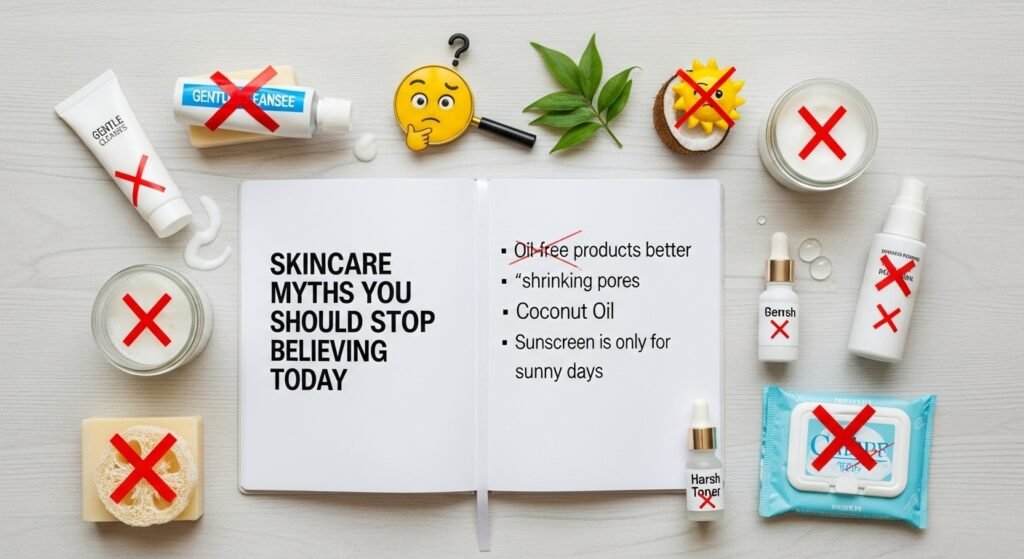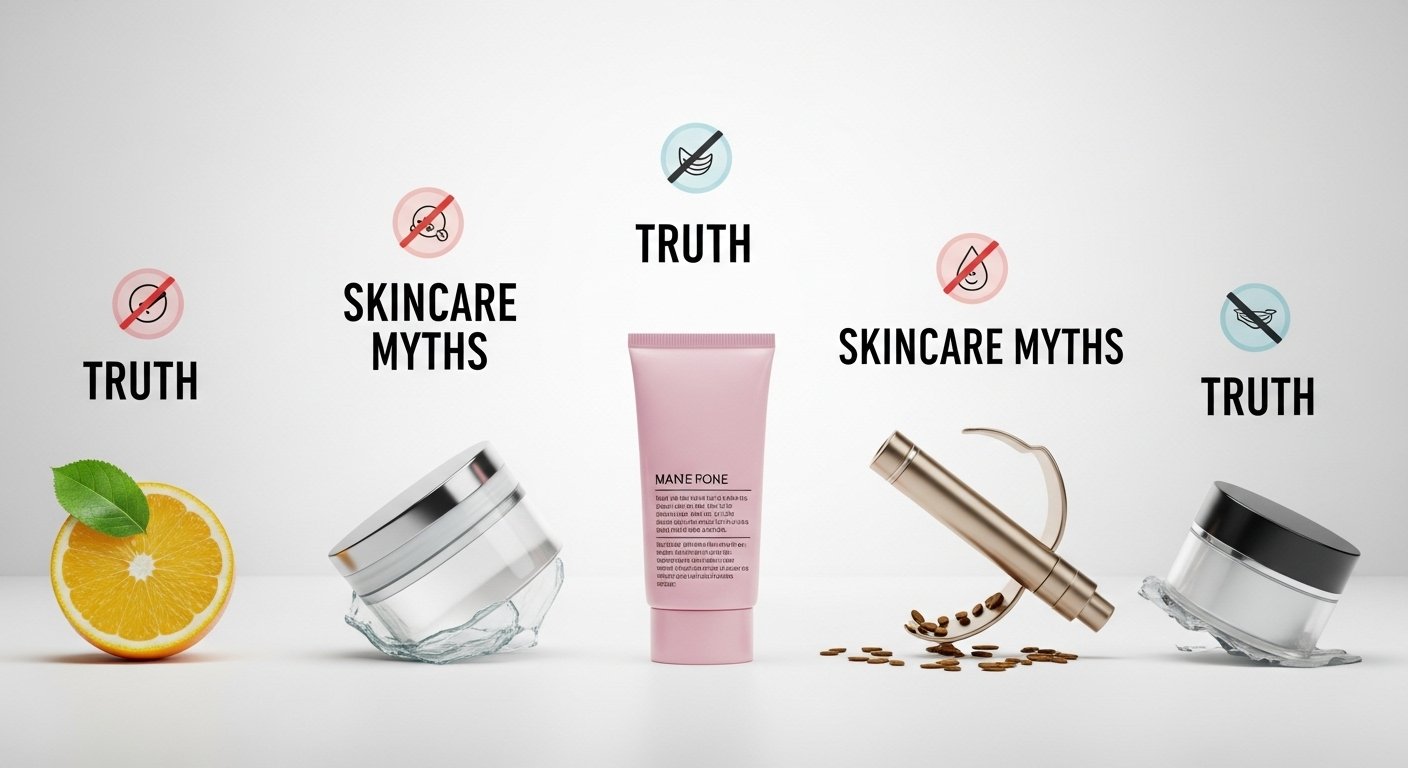5 Skincare Myths You Should Stop Believing Today
Introduction – Why Skincare Myths Still Mislead Us
When it comes to skin care, misinformation travels faster than any serum can sink in. You might hear someone claim that natural DIY skincare is always safer or that skipping sunscreen indoors won’t matter. The truth? These beliefs often do more harm than good.
Having studied esthetics & spa services, I’ve seen how small misunderstandings—like over-exfoliating or ignoring UV rays on cloudy days—can cause dryness, irritation, and long-term aging. In this guide, I’ll debunk five persistent myths and show you practical steps for maintaining healthy, glowing skin through evidence-based habits.

Myth #1 – You Don’t Need Sunscreen on Cloudy Days or Indoors
The Reality Behind UV and Blue Light Exposure
Up to 80 percent of UV rays can penetrate clouds, and UVA rays—the ones that accelerate aging—easily pass through glass windows. That means your skin is still exposed even when you’re indoors or driving.
What You Can Do
- Apply a broad-spectrum SPF 30 or higher every morning.
- Reapply every 2–3 hours, especially near windows or screens.
- Look for antioxidants like vitamin C or green tea extract to neutralize free radicals caused by light exposure.
- Incorporate hydration serums with hyaluronic acid to support the skin barrier.
Myth #2 – Oily Skin Doesn’t Need a Moisturizer
Understanding Skin Hydration and Oil Balance
This is one of the most common skincare myths that leads to unbalanced, irritated skin. People assume that if their face looks shiny, adding moisturizer will make it worse. In reality, skipping hydration triggers the sebaceous glands to produce even more oil to compensate.
A lightweight, non-comedogenic moisturizer helps lock in water without clogging pores. It supports the skin’s protective barrier and prevents dehydration—an underlying cause of oil overproduction.
How to Choose the Right Moisturizer
- Look for labels like oil-free, gel-based, or non-comedogenic.
- Ingredients to consider: niacinamide, hyaluronic acid, and ceramides.
- Apply immediately after cleansing to seal in moisture.
If you run a spa or offer esthetics and spa services, moisturizing education can be integrated into facials and hand and foot spa treatments to reinforce home-care habits.
Myth #3 – Pricey Products Are Always Better
The Reality Behind Skincare Value and Ingredients
A higher price tag doesn’t automatically mean higher effectiveness. Many affordable lines contain proven ingredients such as retinol, peptides, and ceramides—the same actives used in luxury formulas.
What matters most are the concentration, formulation stability, and whether the product suits your skin type and concerns.
When evaluating any skincare or spa service, read the ingredient list first. Dermatologists emphasize consistency and evidence-based formulations rather than brand prestige.
Smart Ways to Shop
Combine professional treatments—such as body laser hair removal or facials—with a simple, steady home routine.
Compare ingredients, not packaging or advertising.
Look for clinical testing or dermatologist recommendations.
Focus on proven actives: retinoids for cell turnover, niacinamide for tone, and peptides for elasticity.
Myth #4 – You Can Shrink Your Pores
Understanding Pore Size and Genetics
Pore size is genetically determined—you can’t make pores physically smaller, but you can make them appear refined and clean. Excess oil, debris, and dead cells can stretch their appearance. Consistent cleansing and exfoliation help keep them unclogged.
Modern dermatology treatments such as chemical peels, hydrafacials, and microneedling with PRP enhance skin texture and reduce visible pore congestion without damage to the skin barrier.
Routine for Refined Looking Pores
- Use a gentle cleanser twice daily.
- Exfoliate 2–3 times a week with salicylic acid or AHAs.
- Apply niacinamide serum to balance sebum and tighten appearance.
- Finish with a lightweight oil-free moisturizer to retain hydration.
Myth #5 – Harsh Scrubbing Gives You Cleaner Skin
Why Gentle Cleansing Matters
Scrubbing too vigorously can strip away your natural moisture barrier, causing irritation, redness, and breakouts. The goal is to cleanse effectively without damaging the protective layer that keeps moisture in and bacteria out.
Dermatologists recommend using lukewarm water and mild, pH-balanced cleansers to remove impurities without dryness. Pair this with gentle exfoliation once or twice a week to support cell renewal.
If you visit a spa college or licensed esthetic clinic, you’ll see that professional facials, waxing, and threading all follow this principle—controlled techniques that respect skin biology.
Steps for Safe Exfoliation and Cleansing
- Step 1: Remove makeup with a gentle micellar solution.
- Step 2: Cleanse with a mild foam or gel cleanser.
- Step 3: Use a soft washcloth or hands instead of abrasive tools.
- Step 4: Follow with toner, serum, and moisturizer.
Conclusion – Follow Science for Healthier, Glowing Skin
Skincare is both art and science. By understanding how your skin functions and filtering out misleading advice, you can build a routine that actually works. Here’s what we learned:
- Sunscreen is non-negotiable — cloudy or clear, indoor or outdoor.
- Every skin type needs hydration to maintain balance and barrier function.
- Ingredients matter more than price tags.
- Pores can be refined, not removed.
- Gentleness wins over force in cleansing and exfoliation.
Whether you’re a student in esthetics & spa services or someone trying to improve your routine at home, these truths help you align with what science and dermatology confirm. With regular care, balanced hydration, and daily protection, you can achieve that consistent glow every skincare enthusiast wants.
FAQ – Frequently Asked Questions
Q: What’s the best daily skincare routine for healthy skin?
A: Cleanse, treat with serum ( vitamin C or niacinamide ), moisturize with a light gel, and apply broad-spectrum SPF 30 or higher every morning.
Q: When should I start anti-aging skincare?
A: Dermatologists suggest introducing preventive products in your mid-20s to support collagen production and delay fine lines.
Q: Can natural ingredients replace clinical skincare?
A: Some natural ingredients help, but not all are safe. Avoid lemon juice or baking soda; they can irritate skin and disrupt pH.

